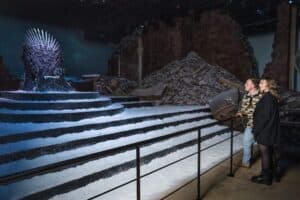Irish music has undoubtedly made an impact across the globe. For centuries, music has been extremely symbolic and has enabled the Irish to communicate with each other almost as well as spoken word. With its beginnings as a form of storytelling passed down between generations, to many, Irish music has become tradition and played an integral part in shaping the Irish identity.
One of the most notable styles of music in Ireland is traditional music. Trad music dates back hundreds of years but gained popularity more recently during one of the largest blights faced by the country, the Great Famine. Like many other historical tragedies, The Great Famine inspired new styles of songwriting that served as both entertainment and distraction from devastating times, shaping traditional music to become what many of us are familiar with today.

Traditional music has evolved into many varieties and incorporated instruments such as the harp – the emblem of one of Ireland’s most notable brands, Guinness – bodhran, fiddle, tin whistle, and Uilleann pipes, many of which are still used throughout the different varieties of traditional music, such as reels, ballads, and Sean-nos.
Reels
One of the most common varieties of traditional music is the reel. Reels are common throughout the pub scene and social settings in Ireland, where both locals and visitors enjoy singing, dancing, and tapping along to the music. From reels grew Irish step dance – a popular southern-style of dance, as well as jigs – folk dances typically performed in accompaniment to an upbeat tone.
Ballads
Ballads, on the other hand, are traditionally considered to be more “folk” in nature, highlighting topics rooted in Irish history and culture. They are well known for their poetic manner, sing-song tune and timeless melodies and lyrics that speak from the Irish perspective.

Sean-Nos
In addition to reels and ballads, Sean-nos is a style of song that uses a story-telling style and is traditionally sung by an individual in the Irish language. While Irish music tends to be upbeat and energetic, Sean Nos is usually more melancholy and heartfelt. Many songs in this style are sung like stories that describe historical and emotional elements of Irish culture such as highlighting the struggles faced by many through these hard times.
Ireland’s Influence
While traditional music has been celebrated across Ireland for generations, it has made its impact worldwide over the past century. During a period of mass emigration due to the Famine, many individuals who left Ireland brought a piece of their home to America where it evolved into some of the most transformative folk music many of us are familiar with today. In addition to folk, genres such as bluegrass, rock, and blues have been impacted and shaped by Irish music as well.
As time went on, traditional music became more modernized as communication and outside influences grew. Beginning in the 1980’s, Irish-Rock and Irish-Alternative music quickly spread across the globe, breaking records and shaping the music industry for decades to come.

Through their music, Irish artists like U2, The Cranberries, and Sinead O’Connor were a few of the individuals that transformed traditional music by reflecting on historical Irish events and incorporating elements of rock, while other artists such as Van Morrison and Enya added soulful tones into their music. Additionally, in the 1990’s, Riverdance – a travelling show consisting of traditional music and dance such as ballet, tap, and jazz found success in North America and contributed to the boom of Irish influence worldwide.
Keeping the Tradition Alive
Although it is known for its history of global influence, Irish music is not just a thing of the past. Today, Irish artists are still topping the charts, incorporating both modern and traditional elements in their music. Hozier, a singer from County Wicklow, as well as the Irish band Kodaline, are keeping the traditional components in their music alive through their alternative-Indie style of music that continues to remain popular globally in today’s new musical age.
While Ireland’s musical influence has impacted the industry on a global level, Irish music is very much alive at its source. Individuals are able to hear century old stories and tales being told through song at local pubs, stream the latest hits, or go see their favorite band playing live in-concert.
Throughout history, music has allowed individuals across Ireland to connect to one another, to their country, and with the world on a global scale. With new influences, styles, and artists on the rise, music will continue to connect individuals world-wide for generations to come.Though many individuals today believe that Irish music no longer sticks to its traditional origins, musical groups such as The Chieftains and The Dubliners have built their image around trad music and are continuing to tour across the globe, keeping the country’s musical roots in-tact.
To learn more about what Ireland has to offer, click on the link below.





